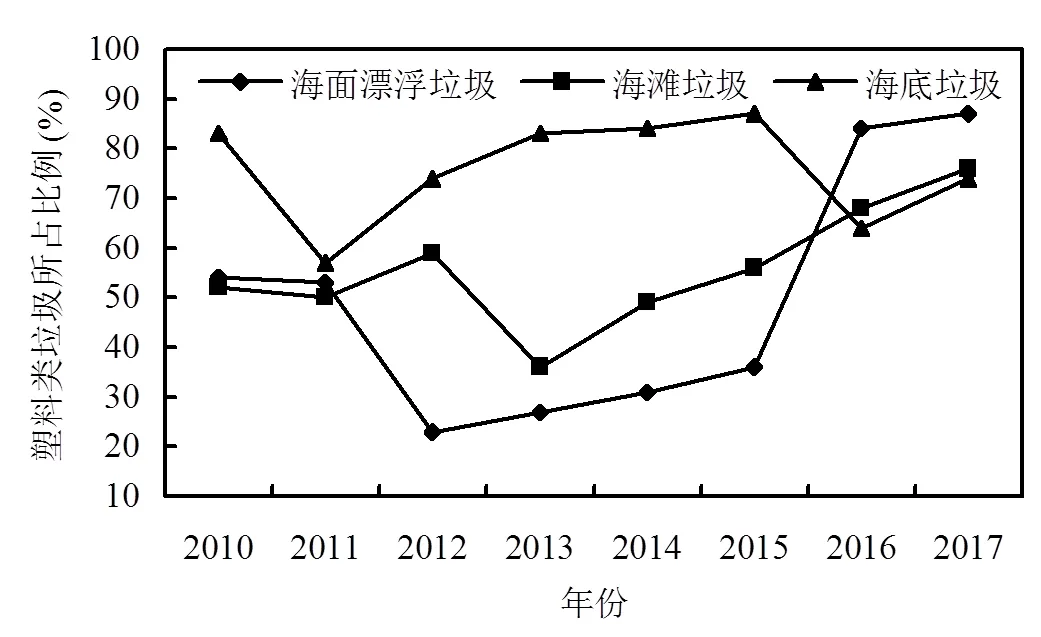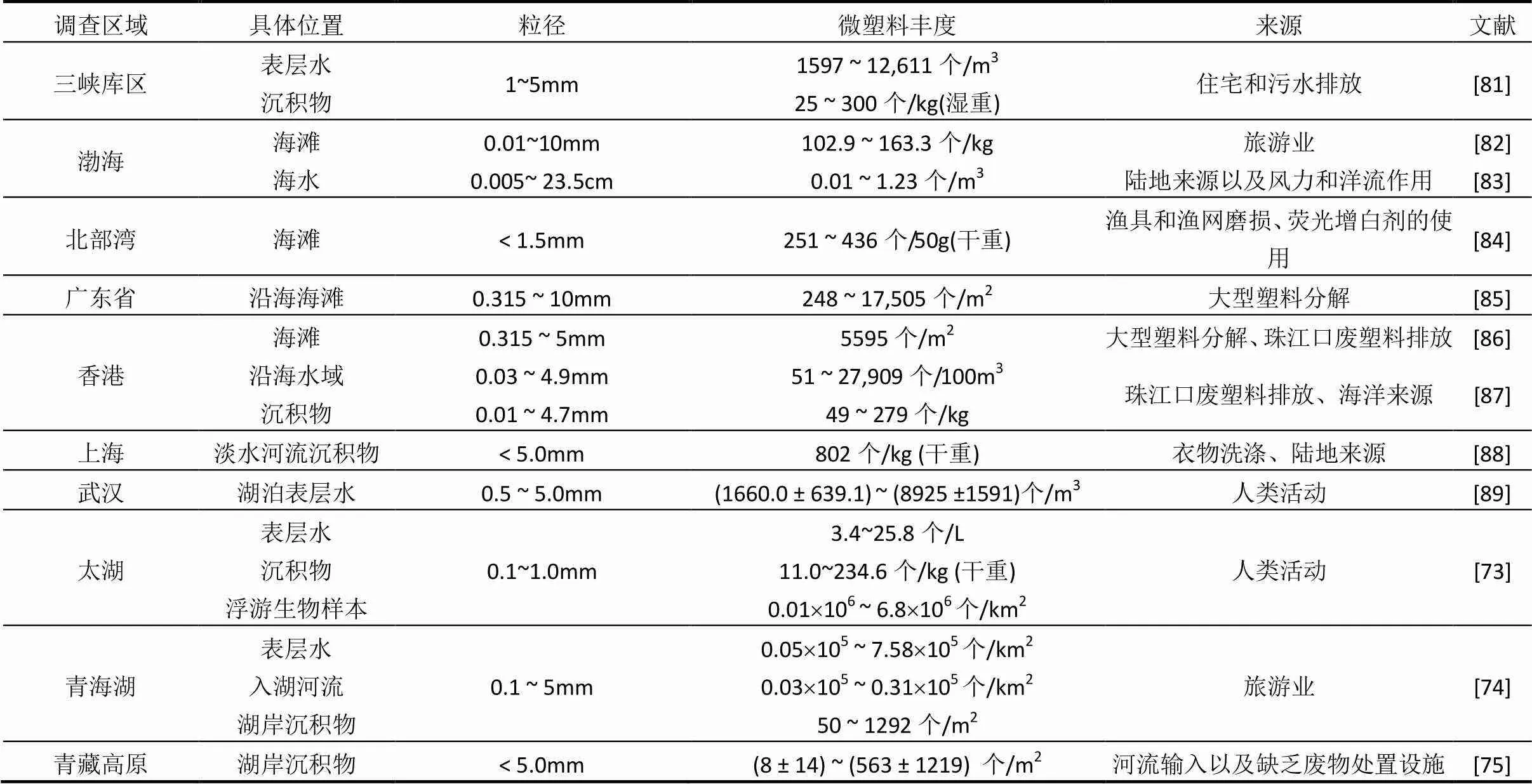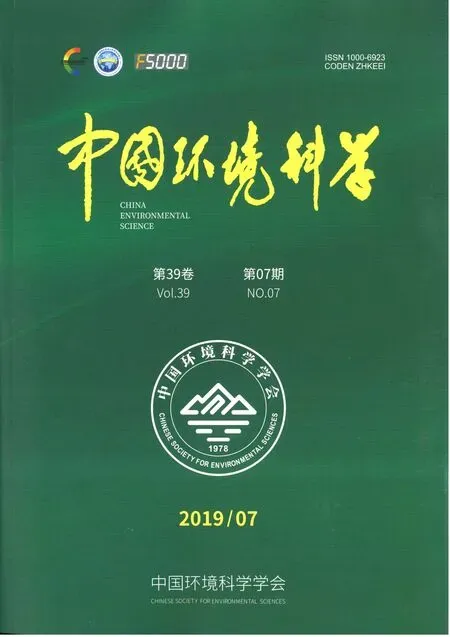中国海洋微塑料污染现状与防治建议
王佳佳,赵娜娜,李金惠
中国海洋微塑料污染现状与防治建议
王佳佳,赵娜娜*,李金惠*
(清华大学环境学院,北京 100084)
微塑料作为一类新型的塑料污染物,广泛存在于全球海洋环境中,已经成为国际社会普遍关注的热点环境问题,管理不善的废物是海洋污染的重要来源.本文简要分析了全球塑料垃圾和微塑料污染形势以及微塑料的来源,探讨了巴塞尔公约所涉及塑料废物附件修订的最新进展,同时总结分析了我国沿海、河口以及内陆水域微塑料的粒径大小、含量、分布和来源.提出未来应建立健全我国塑料和微塑料管理体系,加强对重点行业向海洋中排放塑料和微塑料的研究和监管,建立微塑料对海洋生态系统影响的风险评价体系、加强宣传和教育、积极参与国际环境公约履约谈判以推动全球治理
塑料碎片;微塑料;海洋环境;防治建议;中国
近年来,随着塑料及对海洋生态系统潜在影响的报道,社会对海洋塑料垃圾的研究和关注逐渐增加[1-2].微塑料通常指直径在1nm~5mm范围的塑料颗粒,而对于直径小于2mm的塑料颗粒定义为塑料微粒,又名塑料微珠或塑料柔珠[3].随着研究深入,联合国环境署等国际组织相继发布多份海洋微塑料报告[4-6],论述了海洋微塑料的来源、分布和危害等,海洋塑料污染日渐成为关注焦点.目前大型塑料碎片和微塑料除在大西洋[7-8]、太平洋[9-10]、印度洋[11]等大洋沿海大量分布,甚至在偏远的极地[12-14]和深海[15-17]都发现微塑料的踪迹.研究发现北极海冰每m3水中含有多达238个微塑料颗粒,达太平洋垃圾漂浮带所报道分布浓度的2000倍[18].更甚,从北冰洋的5个地区采集的岩心样本中检测到每升海冰中微塑料的浓度超过12000个颗粒,比以往记录高出2~3倍[19].除了海洋生态系统,更接近微塑料直接来源的淡水系统包括湖泊、河流中也发现了微塑料的踪迹[20],来自五大洲14个国家的自来水样本中,检测发现83%自来水含有微塑料成分[21],而瓶装水中的塑料微粒数量多达自来水的2倍,无处不在的微塑料也已经渗透到海盐、鱼类、贝类、食糖、蜂蜜和啤酒等日常消费的基本产品中[22-23].尽管微塑料对海洋生态系统,包括海洋生物、生物多样性以及人类健康的潜在影响尚不清晰[24],但微塑料被各种各样的海洋生物群摄食已有记录[25-26],即使是小型海洋无脊椎动物也可能摄取[27],导致生理机能紊乱[28],受到微塑料污染的海洋鱼类可以通过食物链进行传递、积累,进而对人类健康产生一定的影响[29].由于目前为止仍缺乏有效的方法追踪微塑料的来源,极难从开放的海洋环境去除,因此,有效控制海洋微塑料的策略是减少塑料垃圾向海洋中的排放.本研究通过文献调研,综述了全球海洋中塑料的污染现状,微塑料的主要来源、巴塞尔公约对塑料的管制要求、以及我国长江口、内陆湖泊和沿岸海水微塑料的研究现状,并提出建议,为未来加强我国减少塑料和微塑料污染的管理能力提供参考.
1 全球塑料污染现状
自20世纪50年代初大规模生产以来,人类已经生产了83亿t塑料,远超过其他人工合成材料[30-31].据欧洲统计局公布的数据显示,2016年全球塑料产量3.35亿t[32],预计到2035年,塑料产量预计将再翻1倍,到2050年将几乎翻2倍,高达11.24亿t[33].随着塑料制品需求不断增长,全球已累计产生63亿t塑料废物,但只有6亿t(9%)被回收利用,绝大多数废塑料被弃置于垃圾填埋场或海洋等生态系统中累计[31].美国佐治亚大学的统计结果显示,每年有大量塑料垃圾从陆地流入海洋,高达1270万t[34],对海洋生态系统的环境造成的经济损失高达130亿美元[24,35-36].如果按照目前的生产趋势和使用模式,且塑料废物管理和基础设施没有进一步改善,海洋塑料垃圾的污染量到2025可能比2015年翻3倍,达到1.55亿t左右,而到2050年,世界海洋中的塑料碎片重量将超过鱼类[33,37],几乎全部海鸟都会误食塑料碎片[38].
由于塑料碎片的迁移受其物理特性(如密度、尺寸、形状和浮力)和海洋动力学条件(水动力过程、风、波浪和洋流)的控制[39-41],这些塑料碎片在洋流和旋涡的作用下可远距离迁移,占全球海洋垃圾的60%~90%[42-44].其中,密度是影响微塑料最终流向的主要变量,比海水密度大的微塑料(例如聚氯乙烯)最有可能沉在海底沉积物中,而低密度微塑料(例如聚丙烯)往往漂浮在海面,分散在水体中[45].然而,添加剂、风化、生物淤积过程可能会改变其密度,导致降低浮力和加速沉降速率[46-48],最近潮滩沉积物[3,49]、近海海底和深海海底沉积物中也发现了低密度微塑料[15,50-51].
2014年Eriksen等[52]研究指出,全球海洋中至少有5.25万亿个,重达约26.9万t的塑料碎片漂浮在海面上,且不包括海底或海滩上的塑料碎片.而最近的估算甚至更高,海面和海岸线上塑料颗粒可达15~51万亿个[53-54],比银河系中的恒星多500倍,全球海洋正在沦为真正的“塑料汤”.
2 海洋微塑料的来源
海洋微塑料污染多元化,其来源可大致分为初生和次生来源微塑料,目前这两种来源的微塑料可通过多种途径包括河流系统、海岸线、污水流出、城市暴雨径流、水产养殖设备的磨损、不当的处置和倾倒、海洋活动事故泄漏、甚至大气排放[55]释放到海洋环境中.其中,“初生”微塑料指经过河流、污水处理厂[56-57]等排入海洋环境中的塑料颗粒工业产品,多来源于日常生活中的化妆品或者清洁用品[58-59]如牙膏和去角质膏中使用的摩擦剂“微珠”,纺织品和纤维服装[60],陆地运输过程的轮胎磨损以及塑料制品加工、成型过程中也会产生塑料颗粒.“次生”微塑料是由大块塑料经过物理、化学和生物过程造成分裂和体积减小而成的塑料颗粒,可以直接从海岸线或通过河流和污水管道进入海洋.实际上,当大型塑料碎片暴露在紫外线照射下,会加速其风化和破碎过程,一旦进入海洋环境中,这一过程就会变的非常缓慢,那些标记为“生物可降解的”塑料在海洋中就不会被快速分解,可在海洋环境中存在数百至数千年,对环境造成持久影响.联合国数据显示[4],海洋中15%~31%的微塑料主要是初生来源,其中,陆源活动占初生微塑料来源的98%[61-65],其余2%来自渔业和运输部门[66],渔具和其他设备的日常磨损以及突发的货物海上运输事故也会产生塑料树脂颗粒.
3 巴塞尔公约对塑料管制要求
为了解决发达国家向发展中国家出口危险废物的全球环境问题,保护人类健康和环境,特别是保护发展中国家的环境利益,《控制危险废物越境转移及其处置巴塞尔公约》(以下简称“巴塞尔公约”),于1989年获得通过,1992年开始生效,截止2018年7月,缔约方共186个[67].《巴塞尔公约》的管辖范围涵盖“危险废物”和“其他废物”,前者包括公约附件一和附件八清单中列明的危险废物,以及缔约方国家立法确定的危险废物,后者包括从住家收集的废物及其焚化残渣,并赋予了缔约方可通过国家立法扩大危险废物范围和采取更严格管控措施的权利.此外,附件九作为非危险废物,其越境转移原则上不受公约制度约束.公约对危险废物越境转移的控制是通过通知书制度来实现的,通知书制度以“事先知情同意”程序(PIC)为核心,是公约控制系统的基础.公约规定,危险废物和其他废物越境转移时必须履行事先知情同意程序.即,只有在出口国向进口国和过境国主管部门递交事先书面通知,并得到书面同意后,才能进行危险废物和其他废物的越境转移.公约所涉及的受管制和不受管制的塑料废物相关名录如表1所示.
2014年6月,首届联合国环境大会上提出了海洋废弃物和微塑料问题,并最终达成了“海洋塑料废物和微塑料决议”,提出开展有关海洋塑料废物和微塑料的研究,并邀请《斯德哥尔摩公约》秘书处、《巴塞尔公约》秘书处及有关化学品及废物管理的相关机构参与上述研究[67].2017年,巴塞尔公约缔约方大会第十三次会议(COP 13)将海洋废塑料和微塑料相关内容纳入工作计划,鼓励各方开展相关工作.2018年6月2日,考虑到废塑料对海洋微塑料的影响,挪威政府向巴塞尔公约秘书处提交修订公约附件的建议,建议将固体塑料废物(B3010)从公约附件九(不受公约管控的废物)中删除,增加入公约附件二(其他废物,受公约管控)中,并于2018年9月的巴塞尔公约不设成员名额工作组第11次会议(OEWG 11)会间提出了关于塑料废物的伙伴关系.OEWG 11决定提请COP 14考虑是否修改附件中塑料废物(B3010)条目,以及如果修订、以何种形式开展,并提请COP 14审议公约项下海洋塑料垃圾和微塑料的行动建议和废塑料伙伴关系计划.2019年5月的COP 14上最终通过了塑料废物附件修正案,将于2021年1月1日起对未提出反对声明的缔约方生效.与公约现有规定相比,塑料废物附件修正案主要变化包括:在附件二和附件八中增加了塑料废物条目;大幅度减少了附件九的塑料废物类别和范围,仅允许“几乎不污染不混合”的单一品种塑料废物和分类回收的聚丙烯(PP)、聚乙烯(PE)和聚对苯二甲酸二乙酯(PET)混合塑料废物,并将“非卤化聚合物和多聚物的塑料废物”的类别从20类缩减为6类;增加了列入附件九的塑料废物最终应进行环境无害化回收的要求;在附件二中增加了“各国可采取更严格要求”的规定,对附件九的“几乎不污染不混合”的塑料废物的分类标准规定“可参考执行相关国际和国家技术文件”.可以看出,塑料废物已明确纳入巴塞尔公约管辖范围,并赋予了各缔约方可以对公约不受控的塑料废物采取更严格管控要求的权利,即未经出口国、过境国和进口国主管当局的事先通知和同意,将不能随意越境转移塑料废物,会促使出口国加强国内塑料废物的管理,加强国内废塑料回收处理处置设施的能力建设,从而避免塑料废物的管理不善.
表1《巴塞尔公约》所涉及的塑料废物名录

Table 1 List of plastic waste covered by the Basel Convention
4 我国微塑料污染现状
4.1 概况
中国是世界上最大的塑料生产与消费国,废塑料及其环境污染问题日益凸显.国外研究报告显示,基于固体废弃物、人口和经济状况模型假设,中国是从陆地流入海洋的塑料垃圾最大源头国,占到192个沿海国家和地区排放总量的近三分之一[34].河流作为污染全球海洋的塑料垃圾的重要来源,连通着内陆与海洋,全球57条河流每年向海洋中输送47万~275万t塑料垃圾,其中包括中国境内的6条河流,分别是长江、黄河、海河、珠江、黑龙江、澜沧江,每年仅长江就有大约150万t塑料垃圾流入黄海[68].以上估算模型可能并不适用于我国[69],但也将我国推上了国际舆论的风口浪尖.

图1 2010~2017年我国近海海面、海滩以及海底垃圾中塑料垃圾的比例
为加强全球海洋垃圾和塑料垃圾的治理,自2007年起,国家海洋局在我国沿海近岸50多个代表性区域组织开展了海洋垃圾监测,内容包括海面漂浮垃圾、海滩垃圾和海底垃圾的种类、数量和来源.根据《2017年中国海洋生态环境状况公报》,海洋垃圾密度较高的区域主要分布在旅游休闲娱乐区、农渔业区、港口航运区及邻近海域,其中,海面漂浮垃圾、海滩垃圾以及海底垃圾中塑料垃圾最多,分别占到87%、76%和74%.2013~2017年,我国海面漂浮垃圾和海滩垃圾中塑料垃圾的比例逐年上升,分别上升60%和40%(图1).虽然近2年海底垃圾中塑料垃圾比例较2015年略有回落,但随着海面漂浮塑料垃圾的增多,也会导致未来海底塑料垃圾的积累.
2016年,国家海洋局启动了我国近海的微塑料监测工作,随后又将范围扩大至大洋和极地领域.监测结果显示,我国沿海表层水体微塑料平均密度约为0.08个/m3,基本与地中海西北部[70]、濑户内外海[71]等处于同一水平,海滩上的微塑料密度介于245 ~ 504个/m2.
4.2 研究现状
2014年以来,国内研究学者对一些典型河口、海湾、海岛、近海(渤海)、潮滩以及内陆湖泊开展了微塑料污染的初步调查.表2归纳了我国微塑料的分布、数量、粒径以及来源.可以看出,中国长江口微塑料丰度相对较高,比海洋和淡水含量高几个数量级,达到4137个/m3[72].而内陆湖泊如洞庭湖和洪湖微塑料的平均含量分别达到1191.7,2282.5个/ m3[20].其他内陆水域包括太湖[73]、青海湖[74]、甚至是青藏高原的湖泊[75]也检测到微塑料的存在.从监测到的微塑料形态、颗粒大小以及塑料类型分析,最常见的形态是塑料纤维,其次是颗粒、薄膜和塑料球,粒径一般在5.0mm以下,微塑料的类型主要为聚乙烯(PE)、聚丙烯(PP)、聚苯乙烯(PS)等.从微塑料的来源来看,主要来自衣物洗涤、生活污水和工业废水排放、水产养殖设施磨损等人为活动.此外,国内渔业市场双壳类动物[76]以及食盐中也有发现微塑料污染情况[77].因此,微塑料已普遍存在于我国河口、内陆淡水环境、沿岸的海水以及生物体中,微塑料对我国海洋生态环境的影响不容忽视.

表2 我国沿海、河口以及内陆水域微塑料的分布、丰度、粒径以及可能的来源

续表2
4.3 加强我国海洋微塑料污染防治的建议
目前,各国已开始在微塑料管理方面采取措施,蒙古、新西兰、智利、印度等国颁布了关于一次性塑料产品销售和使用的禁令,很多发达国家也已经颁布了针对化妆品的微塑料禁令,逐步停止或禁止在化妆品和个人护理产品中使用塑料微珠[90].近年来,我国也加快了相关研究步伐,但我国近海海洋环境中微塑料主要来源、分布规律、路径、通量尚不清楚,也未建立统一的分析标准和监测方法,同时,缺乏生态环境风险评估,公众对微塑料污染的认知程度也较低.因此,针对国内微塑料污染防治工作提出如下建议:
(1)建立和完善我国塑料和微塑料管理体系,出台针对微塑料的立法和公共政策.
国家环境、经济以及工业等监管部门应加强对塑料(或微塑料)产品在生产和使用环节,以及对塑料垃圾的收集、再利用、再循环、回收和(或)环境无害化处置的全生命周期的管理,并制定监测指标、标准和措施.同时,尽快开展限制微塑料产品的生产和使用的立法调查工作,逐步有序制定出台禁止进口、生产和销售在个人洗护用品中使用塑料微珠的法律法规.
(2)开展我国重点行业减少和控制海洋塑料垃圾和微塑料污染的主要路径研究.
分析我国重点行业如塑料生产加工企业、纺织和服装业、船舶运输业、渔业、化妆品行业、农业生产、旅游业等向近海、沿岸河口、排污口排放塑料垃圾和微塑料的基本情况[91],识别我国废塑料和微塑料污染的主要来源、途径和分布情况,从源头上减少和控制塑料垃圾和微塑料进入海洋环境.同时,加强与沿海国家在海洋塑料垃圾、微塑料减量化、资源化和无害化经验和做法方面的合作与交流,为我国提供经验借鉴.
(3)加强微塑料对海洋生态系统的风险评估研究.
由于微塑料污染对生态系统和人类健康存在潜在风险,亟需探明海洋生物对微塑料摄食的影响以及食物链传递和转化过程,研究微塑料吸附有毒化学物质后的环境毒性和生态毒理、迁移路径[92]及生物积累规律,建立我国微塑料对生态环境影响的评价体系,为我国微塑料的防治和决策提供科学依据.
(4)积极加强我国海洋塑料污染应对能力建设,与国际社会共同控制和减少海洋塑料垃圾污染.
考虑到国内外学术和媒体高度关注我国废塑料和微塑料的污染,我国应主动面对,宣传我国在打击废塑料等再生资源污染方面开展的工作,加强国际社会对我国政策的理解和认可.积极支持国际环境公约的谈判,以便从国际公约角度为我国乃至全球其他国家制定废塑料进口管理相关政策提供国际法律层面的支持.
(5)开展公众意识提高和宣传活动.
加大对微塑料污染危害性的宣传力度,积极开展微塑料污染防治的相关科普宣传工作,扩大公众对海洋微塑料的认知,引导消费习惯;鼓励和引导民众以及外卖、快递、电商等行业减少对于一次性(短消费周期)塑料制品的使用,选择可循环使用的替代品,自觉抵制一次性塑料产品,从而减少塑料垃圾的产生.
[1] Carpenter E J, Smith K L. Plastics on Sargasso sea surface [J]. Science, 1972,175:1240-1241.
[2] Wong C S, Green D R, Cretney W J. Quantitative tar and plastic waste distribution in the Pacific Ocean [J]. Nature, 1974,247:30-32.
[3] Thompson R C, Olsen Y, Mitchell R P, et al. Lost at sea: Where is all the plastic? [J]. Science, 2004,304:838-838.
[4] Boucher A J, Friot D. Primary microplastics in the Oceans: a Global Evaluation of Sources [N]. Gland, Switzerland: IUCN, 2017.
[5] Kershaw P J, Rochman C M. Sources, fate and effects of microplastics in the marine environment: part 2of a global assessment [N]. GESAMP, 2015.
[6] Kershaw P J. Marine plastic debris and microplastics – Global lessons and research to inspire action and guide policy change [N]. United Nations Environment Programme, Nairobi, 2016.
[7] Cozar A, Marti E, Duarte C M, et al. The Arctic Ocean as a dead end for floating plastics in the North Atlantic branch of the Thermohaline Circulation [J]. Science Advances, 2017,3.
[8] Law K L, Moret-Ferguson S, Maximenko N A, et al. Plastic accumulation in the North Atlantic Subtropical Gyre [J]. Science, 2010,329:1185-1188.
[9] Law K L, Moret-Ferguson S E, Goodwin D S, et al. Distribution of surface plastic debris in the Eastern Pacific Ocean from an 11-Year Data Set [J]. Environmental Science & Technology, 2014,48:4732- 4738.
[10] Eriksen M, Mason S, Wilson S, et al. Microplastic pollution in the surface waters of the Laurentian Great Lakes [J]. Marine Pollution Bulletin, 2013,77:177-182.
[11] Imhof H K, Sigl R, Brauer E, et al. Spatial and temporal variation of macro-, meso- and microplastic abundance on a remote coral island of the Maldives, Indian Ocean [J]. Marine Pollution Bulletin, 2017,116: 340-347.
[12] Lusher A L, Tirelli V, O'Connor I, et al. Microplastics in Arctic polar waters: the first reported values of particles in surface and sub-surface samples [J]. Scientific Reports, 2015,5.
[13] Waller C L, Griffiths H J, Waluda C M, et al. Microplastics in the Antarctic marine system: An emerging area of research [J]. The Science of the Total Environment, 2017,598:220-227.
[14] Bergmann M, Sandhop N, Schewe I, et al. Observations of floating anthropogenic litter in the Barents Sea and Fram Strait, Arctic [J]. Polar Biology, 2016,39:553-560.
[15] Van Cauwenberghe L, Vanreusel A, Mees J, et al. Microplastic pollution in deep-sea sediments [J]. Environmental Pollution, 2013, 182:495-499.
[16] Taylor M L, Gwinnett C, Robinson L F, et al. Plastic microfibre ingestion by deep-sea organisms [J]. Scientific Reports, 2016:6.
[17] Woodall L C, Sanchez-Vidal A, Canals M, et al. The deep sea is a major sink for microplastic debris [J]. Royal Society Open Science, 2014,1:140317.
[18] Obbard R W, Sadri S, Wong Y Q, et al. Global warming releases microplastic legacy frozen in Arctic Sea ice [J]. Earths Future, 2014, 2:315-320.
[19] Peeken I, Primpke S, Beyer B, et al. Arctic sea ice is an important temporal sink and means of transport for microplastic [J]. Nature Communications, 2018,9:1505.
[20] Wang W F, Yuan W K, Chen Y L, et al. Microplastics in surface waters of Dongting Lake and Hong Lake, China [J]. The Science of the Total Environment, 2018,633:539-545.
[21] Tyree C, Morrison D. Invisibles: the plastic inside us [N]. Orb Media, 2017.
[22] Karami A, Golieskardi A, Choo C K, et al. The presence of microplastics in commercial salts from different countries [J]. Scientific Reports, 2017,7:46173.
[23] Kim J S, Lee H J, Kim S K, et al. Global pattern of microplastics (MPs) in commercial food-grade salts: sea salt as an indicator of seawater MP pollution [J]. Environmental Science & Technology, 2018,52: 12819-12828.
[24] Thevenon F, Carroll C, Sousa J. Plastic debris in the ocean: characterization of marine plastics and their environmental impacts. Situation Analysis Report [N]. Gland, Switzerland: IUCN, 2014.
[25] Wright S L, Rowe D, Thompson R C, et al. Microplastic ingestion decreases energy reserves in marine worms [J]. Current Biology, 2013,23:R1031-R1033.
[26] Wright S L, Thompson R C, Galloway T S. The physical impacts of microplastics on marine organisms: A review [J]. Environmental Pollution, 2013,178:483-492.
[27] Goldstein M C, Goodwin D S. Gooseneck barnacles (Lepas spp.) ingest microplastic debris in the North Pacific Subtropical Gyre [J]. PeerJ, 2013,1:17.
[28] Tanaka K, Takada H, Yamashita R, et al. Accumulation of plastic-derived chemicals in tissues of seabirds ingesting marine plastics [J]. Marine Pollution Bulletin, 2013,69:219-222.
[29] MacMillan A. There’s plastic in your poop: study warns microplastics may be hurting us all [N]. https://www.health.com/home/ microplastics-human-poop, 2018.
[30] He K, Tan Q, Zheng L, et al. Adapting to new policy environment - past pattern and future trend in us-sino waste plastic trade flow [J]. International Journal of Sustainable Development and World Ecology, 2018,25:703-712.
[31] Geyer R, Jambeck J R, Law K L. Production, use, and fate of all plastics ever made [J]. Science Advances, 2017,3:5.
[32] Plastics – the facts 2017: An analysis of European plastics production, demand and waste data [N]. PlasticEurope, 2017.
[33] The New Plastics Economy — Rethinking the future of plastics [N]. World Economic Forum. Ellen MacArthur Foundation and McKinsey & Company, 2016.
[34] Jambeck J R, Geyer R, Wilcox C, et al. Plastic waste inputs from land into the ocean [J]. Science, 2015,347:768-771.
[35] UNEP Year Book 2014: Emerging issues in our global environment [N]. United Nations Environment Programme, 2014.
[36] Raynaud J. Valuing plastic: the business case for measuring, managing and disclosing plastic use in the consumer goods industry [N]. United Nations Environment Programme, 2014.
[37] Stemming the Tide: Land-based strategies for a plastic-free ocean [N]. Ocean Conservancy and McKinsey Center for Business and Environment, 2015.
[38] Wilcox C, Van Sebille E, Hardesty B D. Threat of plastic pollution to seabirds is global, pervasive, and increasing [J]. Proceedings of the National Academy of Sciences of the United States of America, 2015,112:11899-11904.
[39] Critchell K, Lambrechts J. Modelling accumulation of marine plastics in the coastal zone; what are the dominant physical processes? [J]. Estuarine Coastal and Shelf Science, 2016,171:111-122.
[40] Zhang H. Transport of microplastics in coastal seas [J]. Estuarine Coastal and Shelf Science, 2017,199:74-86.
[41] Vermeiren P, Munoz C C, Ikejima K. Sources and sinks of plastic debris in estuaries: A conceptual model integrating biological, physical and chemical distribution mechanisms [J]. Marine Pollution Bulletin, 2016,113:7-16.
[42] Pasternak G, Zviely D, Ribic C A, et al. Sources, composition and spatial distribution of marine debris along the Mediterranean coast of Israel [J]. Marine Pollution Bulletin, 2017,114:1036-1045.
[43] Derraik J G B. The pollution of the marine environment by plastic debris: a review [J]. Marine Pollution Bulletin, 2002,44:842-852.
[44] A Mediterranean full of plastic, research on plastic pollution, impacts and solutions [N]. Greenpeace Spain, 2017.
[45] Chubarenko I, Bagaev A, Zobkov M, et al. On some physical and dynamical properties of microplastic particles in marine environment [J]. Marine Pollution Bulletin, 2016,108:105-112.
[46] Kowalski N, Reichardt A M, Waniek J J. Sinking rates of microplastics and potential implications of their alteration by physical, biological, and chemical factors [J]. Marine Pollution Bulletin, 2016,109:310- 319.
[47] Lobelle D, Cunliffe M. Early microbial biofilm formation on marine plastic debris [J]. Marine Pollution Bulletin, 2011,62:197-200.
[48] Cole M, Lindeque P K, Fileman E, et al. Microplastics alter the properties and sinking rates of zooplankton faecal pellets [J]. Environmental Science & Technology, 2016,50:3239-3246.
[49] Claessens M, De Meester S, Van Landuyt L, et al. Occurrence and distribution of microplastics in marine sediments along the Belgian coast [J]. Marine Pollution Bulletin, 2011,62:2199-2204.
[50] Shimanaga M, Yanagi K. The Ryukyu Trench may function as a "depocenter" for anthropogenic marine litter [J]. Journal of Oceanography, 2016,72:895-903.
[51] Van Cauwenberghe L, Devriese L, Galgani F, et al. Microplastics in sediments: A review of techniques, occurrence and effects [J]. Marine Environmental Research, 2015,111:5-17.
[52] Eriksen M, Lebreton L C M, Carson H S, et al. Plastic pollution in the world's oceans: more than 5 trillion plastic pieces weighing over 250,000 tons afloat at sea [J]. Plos One, 2014:9.
[53] Carr S A, Liu J, Tesoro A G. Transport and fate of microplastic particles in wastewater treatment plants [J]. Water Research, 2016,91: 174-182.
[54] van Sebille E, Wilcox C, Lebreton L, et al. A global inventory of small floating plastic debris [J]. Environmental Research Letters, 2015,10: 124006.
[55] Dris R, Gasperi J, Saad M, et al. Synthetic fibers in atmospheric fallout: A source of microplastics in the environment? [J]. Marine Pollution Bulletin, 2016,104:290-293.
[56] 许 霞,侯青桐,薛银刚,等.污水厂中微塑料的污染及迁移特征研究进展[J]. 中国环境科学, 2018,38(1):395-402. Xu X, Hou Q T, Xue Y G, et al. Research progress on the transference and pollution characteristics of microplastics in wastewater treatment plants [J]. China Environmental Science, 2018,38(1):395-401.
[57] 白濛雨,赵世烨,彭谷雨,等.城市污水处理过程中微塑料赋存特征[J]. 中国环境科学, 2018,38(5):1734-1743. Bai M Y, Zhao S Y, Peng Y G, et al. Occurrence, characteristics of microplastic during urban sewage treatment processs [J]. China Environmental Science, 2018,38(5):1734-1743.
[58] Fendall L S, Sewell M A. Contributing to marine pollution by washing your face: Microplastics in facial cleansers [J]. Marine Pollution Bulletin, 2009,58:1225-1228.
[59] Chang M. Reducing microplastics from facial exfoliating cleansers in wastewater through treatment versus consumer product decisions [J]. Marine Pollution Bulletin, 2015,101:330-333.
[60] Salvador Cesa F, Turra A, Baruque-Ramos J. Synthetic fibers as microplastics in the marine environment: A review from textile perspective with a focus on domestic washings [J]. The Science of the total environment, 2017,598:1116-1129.
[61] Cole M, Lindeque P, Halsband C, et al. Microplastics as contaminants in the marine environment: A review [J]. Marine Pollution Bulletin, 2011,62:2588-2597.
[62] Auta H S, Emenike C U, Fauziah S H. Distribution and importance of microplastics in the marine environment: A review of the sources, fate, effects, and potential solutions [J]. Environment International, 2017,102:165-176.
[63] Saal F S, Parmigiani S, Palanza P L, et al. The plastic world: Sources, amounts, ecological impacts and effects on development, reproduction, brain and behavior in aquatic and terrestrial animals and humans Introduction [J]. Environment Research, 2008,108:127-130.
[64] Browne M A, Crump P, Niven S J, et al. Accumulation of Microplastic on Shorelines Woldwide: Sources and Sinks [J]. Environmental Science & Technology, 2011,45:9175-9179.
[65] Andrady A L. Microplastics in the marine environment [J]. Marine Pollution Bulletin, 2011,62:1596-1605.
[66] Marine litter: An analytical review [N]. Nairobi: United Nations Environment Programme, 2005.
[67] 于海晴,梁迪隽,谭全银,等.海洋垃圾和微塑料污染问题及其国际进程[J]. 世界环境, 2018,171:52-55. Yu H Q, Liang D Y, Peng Y G, et al. The issues of marine litter and microplastics pollution and relevant international process [J]. World Environment, 2018,17:1734-1743.
[68] Schmidt C, Krauth T, Wagner S. Export of Plastic Debris by Rivers into the Sea [J]. Environmental Science & Technology, 2017,51: 12246-12253.
[69] Bai M, Zhu L, An L, et al. Estimation and prediction of plastic waste annual input into the sea from China [J]. Acta Oceanologica Sinica, 2018,37:26-39.
[70] Cocca M, Di Pace E, Errico M E, et al. Proceedings of the International Conference on Microplastic Pollution in the Mediterranean Sea || Sub-Basin Scale Heterogeneity in the Polymeric Composition of Floating Microplastics in the Mediterranean Sea [N]. Springer Water, 2018.
[71] Isobe A, Kubo K, Tamura Y, et al. Selective transport of microplastics and mesoplastics by drifting in coastal waters [J]. Marine Pollution Bulletin, 2014,89:324-330.
[72] Zhao S, Zhu L, Wang T, et al. Suspended microplastics in the surface water of the Yangtze Estuary System, China: First observations on occurrence, distribution [J]. Marine Pollution Bulletin, 2014,86:562- 568.
[73] Su L, Xue Y, Li L, et al. Microplastics in Taihu Lake, China [J]. Environmental Pollution, 2016,216:711-719.
[74] Xiong X, Zhang K, Chen X C, et al. Sources and distribution of microplastics in China's largest inland lake - Qinghai Lake [J]. Environmental Pollution, 2018,235:899-906.
[75] Zhang K, Su J, Xiong X, et al. Microplastic pollution of lakeshore sediments from remote lakes in Tibet plateau, China [J]. Environmental Pollution, 2016,219:450-455.
[76] Li J, Yang D, Li L, et al. Microplastics in commercial bivalves from China [J]. Environmental Pollution, 2015,207:190-195.
[77] Yang D Q, Shi H H, Li L, et al. Microplastic Pollution in Table Salts from China [J]. Environmental Science & Technology, 2015,49: 13622-13627.
[78] Peng G Y, Zhu B S, Yang D Q, et al. Microplastics in sediments of the Changjiang Estuary, China [J]. Environmental Pollution, 2017,225: 283-290.
[79] Zhao S Y, Zhu L X, Li D J. Microplastic in three urban estuaries, China [J]. Environmental Pollution, 2015,206:597-604.
[80] Zhang K, Gong W, Lv J Z, et al. Accumulation of floating microplastics behind the Three Gorges Dam [J]. Environmental Pollution, 2015,204:117-123.
[81] Di M, Wang J. Microplastics in surface waters and sediments of the Three Gorges Reservoir, China [J]. The Science of the Total Environment, 2018,616:1620-1627.
[82] Yu X, Peng J, Wang J, et al. Occurrence of microplastics in the beach sand of the Chinese inner sea: the Bohai Sea [J]. Environmental Pollution, 2016,214:722-730.
[83] Zhang W, Zhang S, Wang J, et al. Microplastic pollution in the surface waters of the Bohai Sea, China [J]. Environmental Pollution, 2017,231: 541-548.
[84] Qiu Q, Peng J, Yu X, et al. Occurrence of microplastics in the coastal marine environment: First observation on sediment of China [J]. Marine Pollution Bulletin, 2015,98:274-280.
[85] Fok L, Cheung P K, Tang G D, et al. Size distribution of stranded small plastic debris on the coast of Guangdong, South China [J]. Environmental Pollution, 2017,220:407-412.
[86] Fok L, Cheung P K. Hong Kong at the Pearl River Estuary: A hotspot of microplastic pollution [J]. Marine Pollution Bulletin, 2015,99:112- 118.
[87] Tsang Y Y, Mak C W, Liebich C, et al. Microplastic pollution in the marine waters and sediments of Hong Kong [J]. Marine Pollution Bulletin, 2017,115:20-28.
[88] Peng G, Xu P, Zhu B, et al. Microplastics in freshwater river sediments in Shanghai, China: A case study of risk assessment in mega-cities [J]. Environmental Pollution, 2018,234:448-456.
[89] Wang W, Ndungu A W, Li Z, et al. Microplastics pollution in inland freshwaters of China: A case study in urban surface waters of Wuhan, China [J]. The Science of the Total Environment, 2017,575:1369- 1374.
[90] Wang J, Zheng L, Li J. A critical review on the sources and instruments of marine microplastics and prospects on the relevant management in China [J]. Waste Management & Research, 2018,36: 898-911.
[91] 邓 婷,高俊敏,吴文楠,等.温州沿海大型塑料垃圾排放特征研究 [J]. 中国环境科学, 2018,38(11):4354-4360. Deng T, Gao J M, Wu W N, et al. Study on the discharging characteristics of large plastic litters along Wenzhou coastal [J]. China Environmental Science, 2018,38(11):4354-4360.
[92] 陈守益,郭学涛,庞敬文.微塑料对泰乐菌素的吸附动力学与热力学[J]. 中国环境科学, 2018,38:1905-1912. Chen S Y, Guo X T, Pang J W. Sorption kinetics and thermodynamics study of tylosin by microplastics [J]. China Environmental Science, 2018,38(11):4354-4360.
Current situation of marine microplastics pollution and prevention proposals in China,
WANG Jia-jia, ZHAO Na-na*, LI Jin- hui*
(School of Environment, Tsinghua University, Beijing 100084, China)., 2019,39(7):3056~3063
Microplastics, as a novel type of plastic contaminant, widely exist in the global marine environment, and have become a hot environmental issue in the international community. Poorly managed waste is an important source of marine pollution. In this paper, the pollution situation of plastic waste and microplastics in the world and the sources of micro-plastics are briefly analyzed. And the latest progress in the revision of annexes to plastic waste covered by the Basel Convention was discussed. Meanwhile, the size, abundance, distribution and sources of microplastics in coastal, estuary and inland waters of China were summarized and analyzed. It was proposed that the management system of plastics and microplastics in China should be established and improved in the future, research and supervision on the discharge of plastics and microplastics from key industries into the ocean should be strengthened, a risk assessment system for the impact of microplastics on marine ecosystems should be established, publicity and education should be strengthened, and actively participate in the negotiations on the implementation of international environmental conventions to promote global governance.
plastic debris;microplastics;marine environment;prevention proposal;China
X145
A
1000-6923(2019)07-3056-08
王佳佳(1989-),女,山东聊城人,清华大学博士研究生,主要从事固体废物处置技术及环境管理研究.发表论文7篇.
2018-12-17
国家重点研发计划资助项目(2018YFC1900101);清华大学自主科研计划资助项目(2016THZWYX12)
* 责任作者, 李金惠, 教授, jinhui@mail.tsinghua.edu.cn; 赵娜娜, 工程师, zhaonana@tsinghua.edu.cn

